No products in the cart.
NEWS
Elevate Your Garden: Creative Vegetable Patch Ideas for Every Space
Starting a vegetable garden is a deeply rewarding endeavor, offering not just fresh, delicious produce, but also significant benefits for your physical and mental well-being. Growing your own organic vegetables ensures you know exactly what goes into your food, reduces your environmental footprint, and provides a taste experience far superior to store-bought alternatives. The process of nurturing seeds into harvestable crops connects you with nature and offers a fulfilling sense of accomplishment.
Whether you have a sprawling backyard or are navigating the limitations of a small patio or balcony, the dream of a productive vegetable garden is entirely achievable. Space constraints don’t have to be barriers; instead, they invite creativity. Techniques like container gardening or vertical setups can transform even the smallest corners into lush sources of food. For those with more room, designing raised garden beds offers structure and ease of management. The key is to explore the possibilities and find the approach that best suits your environment and lifestyle.
When planning your vegetable plot, prioritize growing what you love to eat. This simple rule ensures your efforts are rewarded with satisfying harvests that your household will genuinely enjoy. Don’t be afraid to experiment with interesting or heirloom varieties that offer unique flavors and textures often unavailable commercially. For newcomers to gardening, building confidence with easy-to-grow vegetables such as radishes, bush beans, and zucchini provides early success and practical experience before tackling more challenging crops.
Understanding your local climate is fundamental to selecting vegetables that will thrive. Different crops have varying temperature and light requirements. Warm-season favorites like tomatoes, peppers, and cucumbers require plenty of sunshine and heat, making them ideal for summer months in many regions. Conversely, cool-season vegetables such as lettuce, spinach, and broccoli prefer milder temperatures and can be planted in spring or fall. Researching recommended planting times for your specific area is a vital first step. By exploring a variety of vegetable garden ideas, you can unlock the full potential of your growing space and enjoy abundant harvests throughout the season.
Add Versatile Raised Beds
Growing vegetables in raised garden beds offers a multitude of advantages, making them a popular choice for both novice and experienced gardeners. They are particularly beneficial for challenging sites, such as yards with uneven terrain or poor soil quality. Raised beds allow you to bypass problematic ground conditions by creating a level, contained area filled with custom-blended soil optimized for vegetable growth. This eliminates the years it might take to amend heavy clay or rocky native soil.
Elevated beds also enhance accessibility. Tending to plants, weeding, and harvesting becomes significantly easier, requiring less bending and kneeling – a major plus for gardeners with mobility issues. Furthermore, the soil in raised beds tends to warm up faster in spring, which can extend your planting and harvesting seasons, giving you a head start on cool-season crops and allowing warm-season varieties to thrive earlier.
Perhaps one of the most appealing aspects of raised beds is their aesthetic flexibility and design potential. They provide an attractive, structured element to the garden landscape and can be designed in various shapes, sizes, and materials to fit any style or space. Raised beds can be permanent structures built in place or modular kits that can be assembled and potentially relocated later.
Common materials include wood (like cedar or redwood for durability) and metal. Galvanized or powder-coated steel options are increasingly popular due to their longevity, often lasting two decades or more, representing a solid long-term investment for your gardening passion. Utilizing structures like raised beds simplifies soil management and pest control, creating a more controlled and productive growing environment. As Biogarden.Asia experts often note, “Raised beds are a game-changer for challenging soils and offer incredible flexibility in garden design.”
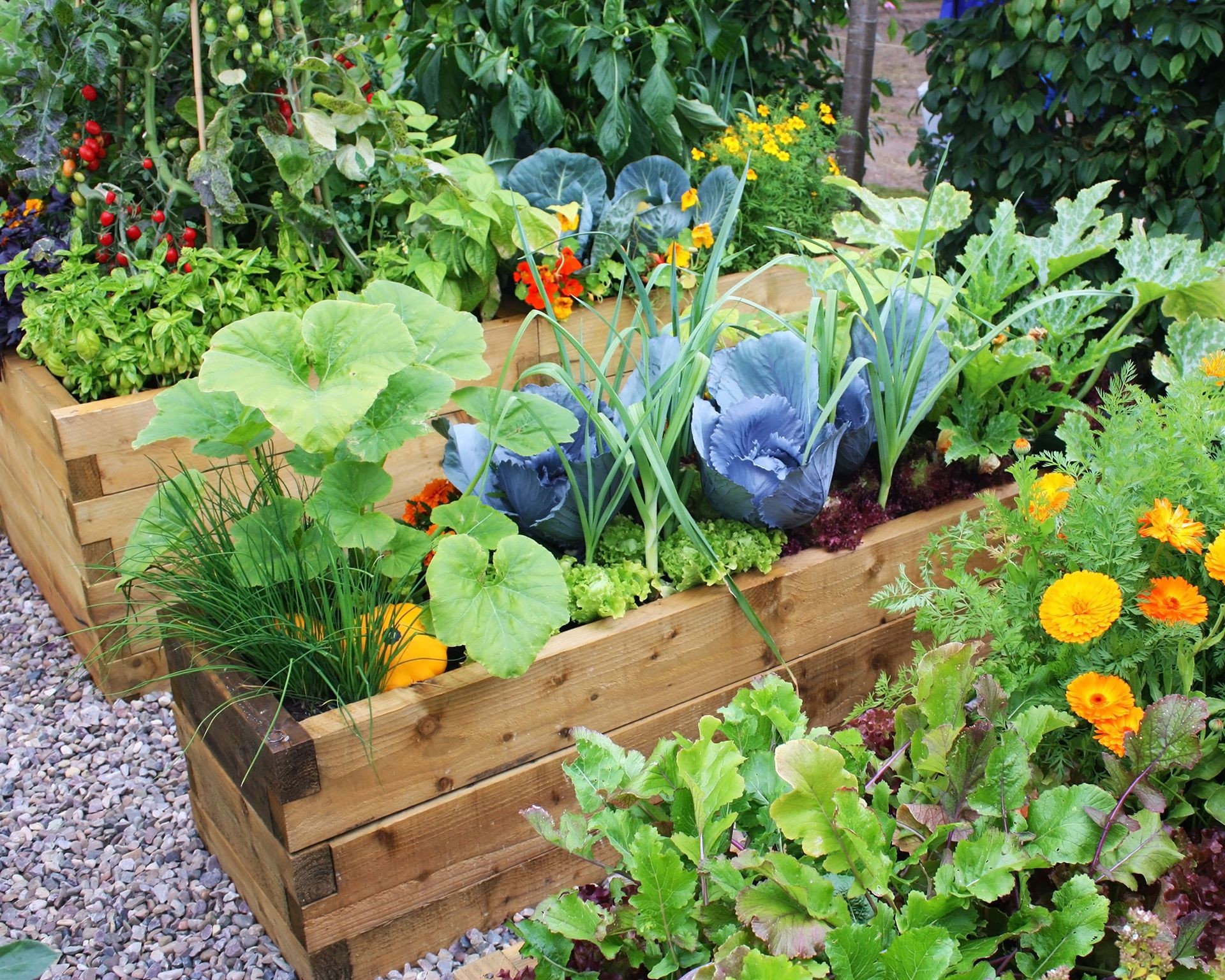 Two tiered raised garden beds made of stacked wood kits filled with thriving green plants
Two tiered raised garden beds made of stacked wood kits filled with thriving green plants
Increase Yields With A Square Foot Vegetable Garden
The square foot gardening method is a brilliant approach focused on maximizing productivity in confined spaces. It’s particularly well-suited for small urban gardens, patios, or even a section of a larger raised bed.
This technique involves dividing the growing area into a grid of 1ft x 1ft (approximately 30cm x 30cm) squares. Each square is then dedicated to a specific crop, with the number of plants per square determined by the mature size of the vegetable. For instance, you might plant 16 radishes, 4 lettuce plants, or just one large tomato plant within a single square. Larger vining plants like squash or melon might sprawl across two squares.
A key benefit of square foot gardening is its simplicity in planning. The grid system takes the guesswork out of plant spacing, making it easy to determine how many plants can fit in your designated area. This highly organized approach encourages efficient use of every square inch, leading to impressive yields from a relatively small footprint. It’s an excellent method for beginners seeking a structured way to manage their planting layout and harvest a diverse range of vegetables.
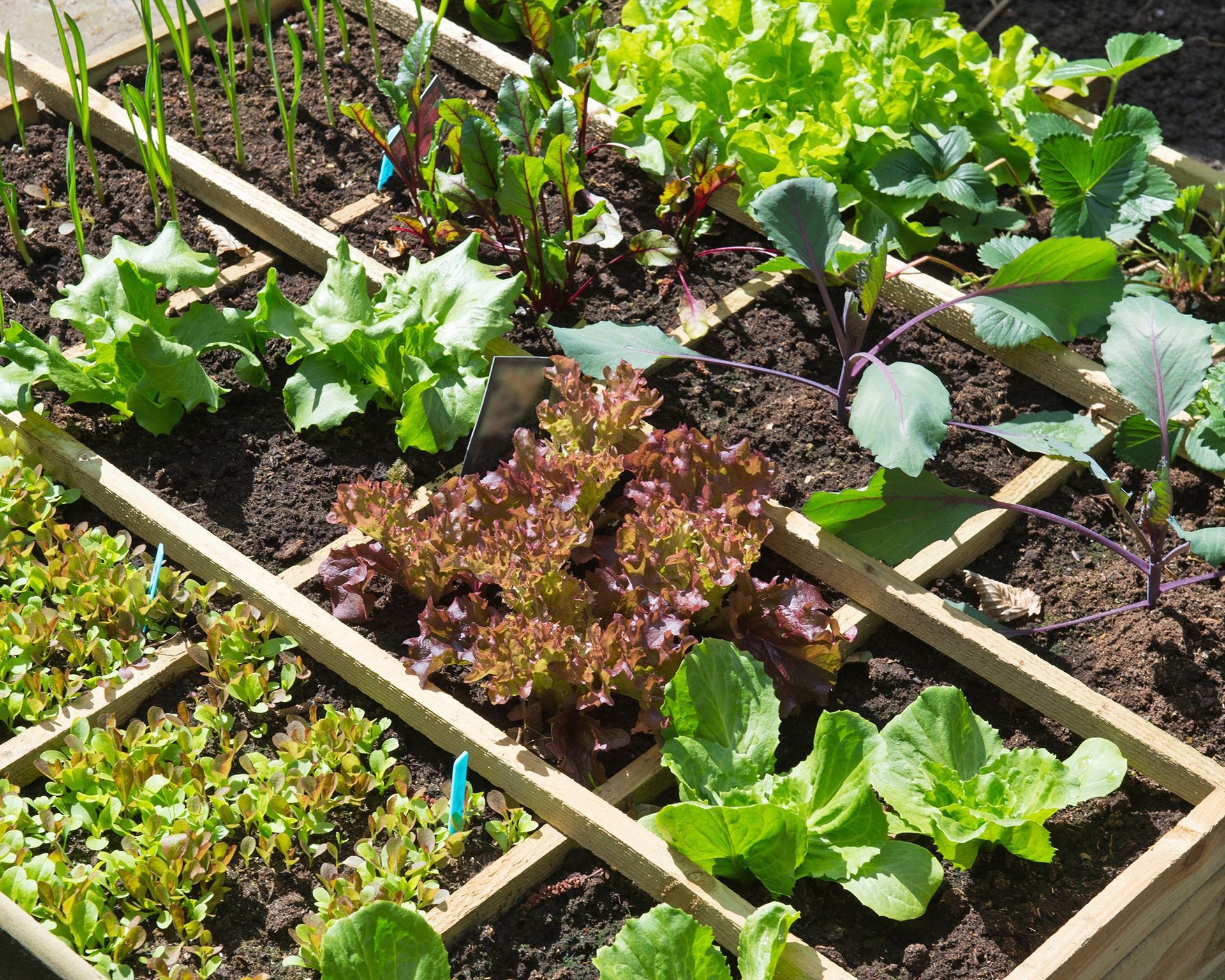 A raised garden bed segmented into one foot squares, each containing different young vegetable plants
A raised garden bed segmented into one foot squares, each containing different young vegetable plants
Build Trellis For Climbing Crops
Incorporating trellises or other support structures for vining vegetables is a highly effective strategy with numerous benefits. Training climbing crops upwards not only conserves valuable ground space but also significantly increases yields and improves plant health by enhancing air circulation, which helps minimize disease risk. Managing pests also becomes easier when plants are grown vertically.
There are countless creative ways to build or install trellises, ranging from simple, cost-effective DIY projects to elegant, decorative structures. Materials like bamboo canes, branches, salvaged wood, or wire mesh can be fashioned into functional supports for climbing plants such as tomatoes, peas, pole beans, cucumbers, and certain types of squash. Even some fruit trees like grapes or figs can be trained on trellises.
Trellises can be purely functional or double as garden features. An attractive arbor covered in vining beans or cucumbers can create a lovely focal point or even a shady retreat. An arched walkway with climbing fruits like passionfruit adds an immersive, edible element to the garden landscape. The versatility of trellising allows for creative design solutions that maximize both space utilization and the aesthetic appeal of your vegetable garden.
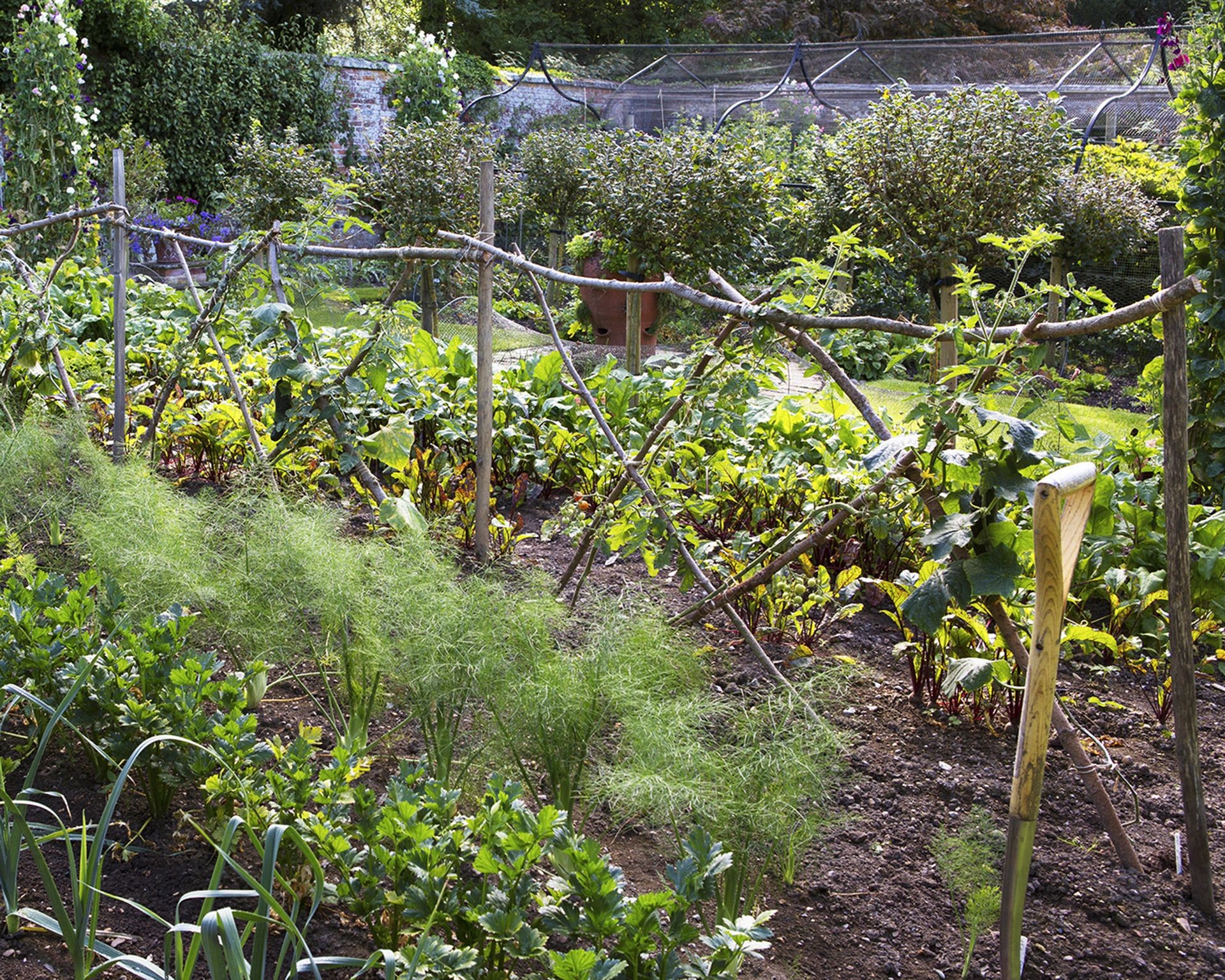 A rustic garden trellis made from natural materials like branches and sticks supporting climbing plants
A rustic garden trellis made from natural materials like branches and sticks supporting climbing plants
Be Clever With Companion Planting
The principle of companion planting is an age-old gardening technique that leverages the beneficial interactions between different plant species. Just as in any community, some plants thrive when grown near certain neighbors, while others can inhibit growth or attract pests. Consciously choosing plant pairings can lead to healthier plants and more abundant harvests.
Good companion plants can serve various functions: deterring common garden pests without chemicals, attracting beneficial insects that prey on pests or aid in pollination, providing physical support, improving soil fertility by fixing nutrients, or even enhancing the flavor of nearby vegetables. Conversely, certain “bad” pairings can stunt growth or attract undesirable insects.
Many herbs are excellent companions in the vegetable garden. Their strong aromas can confuse or repel pests like aphids and spider mites. Basil, for example, is often planted near tomatoes to deter flies and hornworms and is believed by some to improve tomato flavor. Chives can help protect carrots from rust fly. Certain flowers, like marigolds and nasturtiums, are renowned for their pest-repelling properties and add beautiful color to the vegetable patch. Legumes such as beans and peas are classic companions because they fix atmospheric nitrogen into the soil, benefiting heavy feeders grown nearby. The traditional “Three Sisters” planting – corn, beans, and squash – is a prime example of companion planting where the corn provides support for the beans, the beans enrich the soil, and the squash provides ground cover to suppress weeds and conserve moisture.
While many pairings are beneficial, it’s important to research specific plant compatibilities as some good companions for one crop can be detrimental to another. A little planning can prevent negative interactions and maximize the positive synergy in your garden beds. As a Biogarden.Asia specialist might advise, “Think of companion planting as building a balanced ecosystem right in your garden – it’s about creating harmony for healthier plants.”
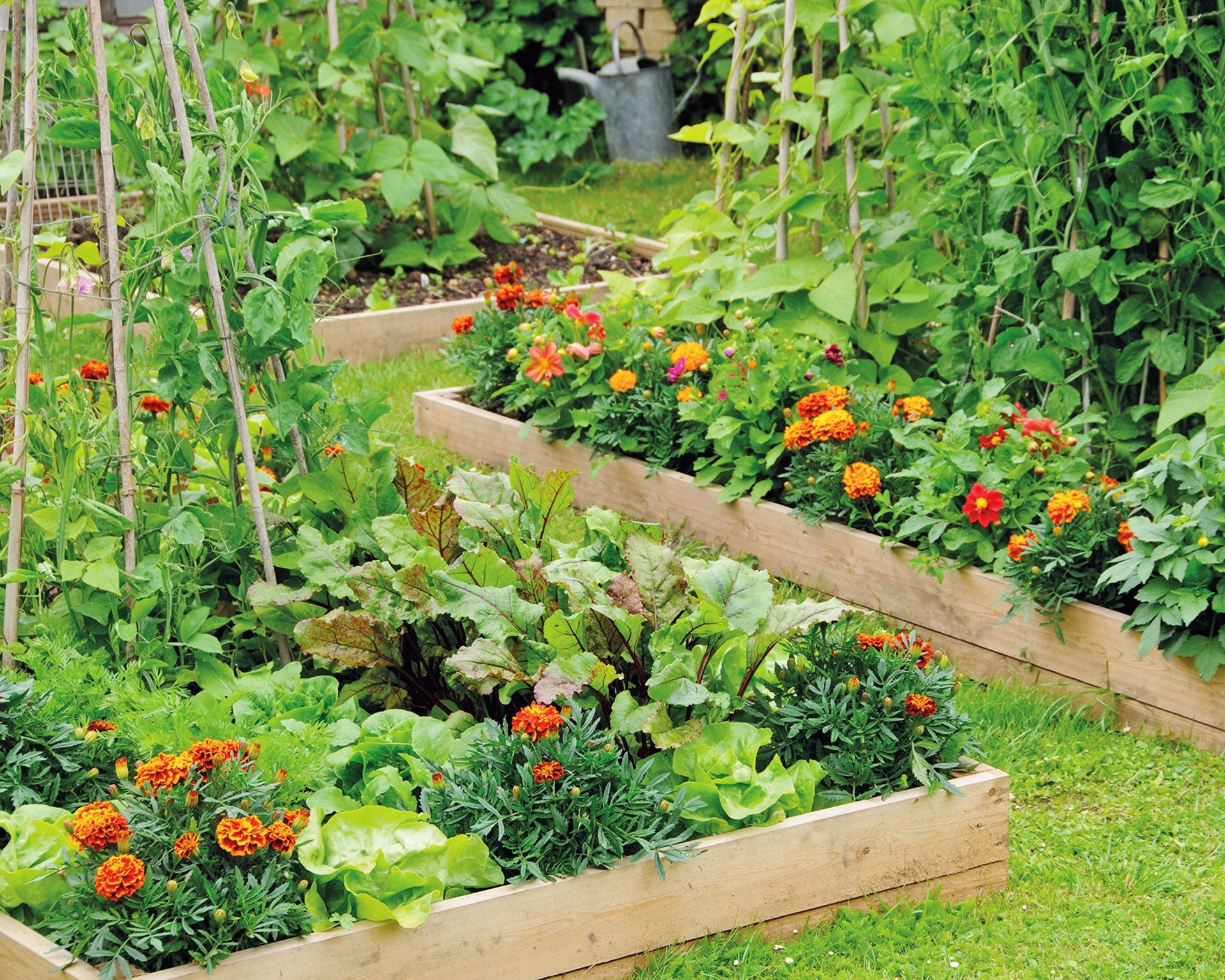 A section of a raised vegetable bed shows lush plants with vibrant orange marigold flowers interspersed, demonstrating companion planting
A section of a raised vegetable bed shows lush plants with vibrant orange marigold flowers interspersed, demonstrating companion planting
Embrace Container Gardening
Container gardening is an incredibly versatile and accessible method, particularly for those with limited or no in-ground planting space. It opens up gardening possibilities on balconies, patios, rooftops, small yards, and even windowsills, allowing urban dwellers and apartment residents to enjoy homegrown produce.
One of the significant advantages of growing in containers is the control it offers over the growing medium. You can fill pots with high-quality, nutrient-rich potting mix tailored to the specific needs of your plants. This also helps mitigate issues with poor native soil and reduces the risk of soil-borne diseases and pests, as the plants are isolated from ground-level threats.
Containers also provide flexibility. You can move plants to follow the sun, protect them from harsh weather, or rearrange your garden layout easily. This adaptability is invaluable for maximizing sunlight exposure throughout the day or season.
While almost any vegetable can be grown in a container with the right pot size and care, some are particularly well-suited. Leafy greens like lettuce and spinach, root vegetables such as radishes and carrots (in deep pots), onions, bush beans, peppers, and many dwarf or determinate tomato varieties thrive in containers. When selecting plants, consider their mature size and choose appropriate container dimensions to ensure adequate root space.
It’s important to note that containers dry out faster than in-ground beds, especially in warm, sunny conditions. Therefore, container gardens typically require more frequent watering. Investing in good quality pots and a suitable watering schedule is key to success. Biogarden.Asia offers a range of planters designed to support healthy vegetable growth in various settings.
Make It Beautiful With Ornamental Herbs
Integrating herbs into your vegetable garden design adds layers of function and beauty. While growing herbs can be a separate pursuit, they are essential additions to any productive edible garden. For those with minimal outdoor space, a dedicated herb garden can offer a rich harvest of flavor and aroma in a small footprint.
Beyond their culinary uses, many herbs serve as attractive ornamental plants, featuring appealing foliage, textures, and flowers. Lavender, rosemary, sage, borage, and chives, for example, are visually striking and can enhance the aesthetic appeal of your vegetable beds or containers.
Many herbs also act as beneficial companion plants. Their strong scents can deter pests, and their flowers often attract pollinators like bees and butterflies, crucial for fruit and vegetable production. Planting perennial herbs offers long-lasting beauty and a continuous supply of fresh flavor year after year.
Choosing herbs that complement your cooking style ensures you’ll make the most of your harvest. Whether you prefer Mediterranean flavors with rosemary and oregano or Asian cuisine with cilantro and mint, selecting herbs you’ll actually use adds practicality to their aesthetic and ecological benefits. Combining edible functionality with ornamental appeal makes herbs an indispensable element in a well-designed vegetable garden.
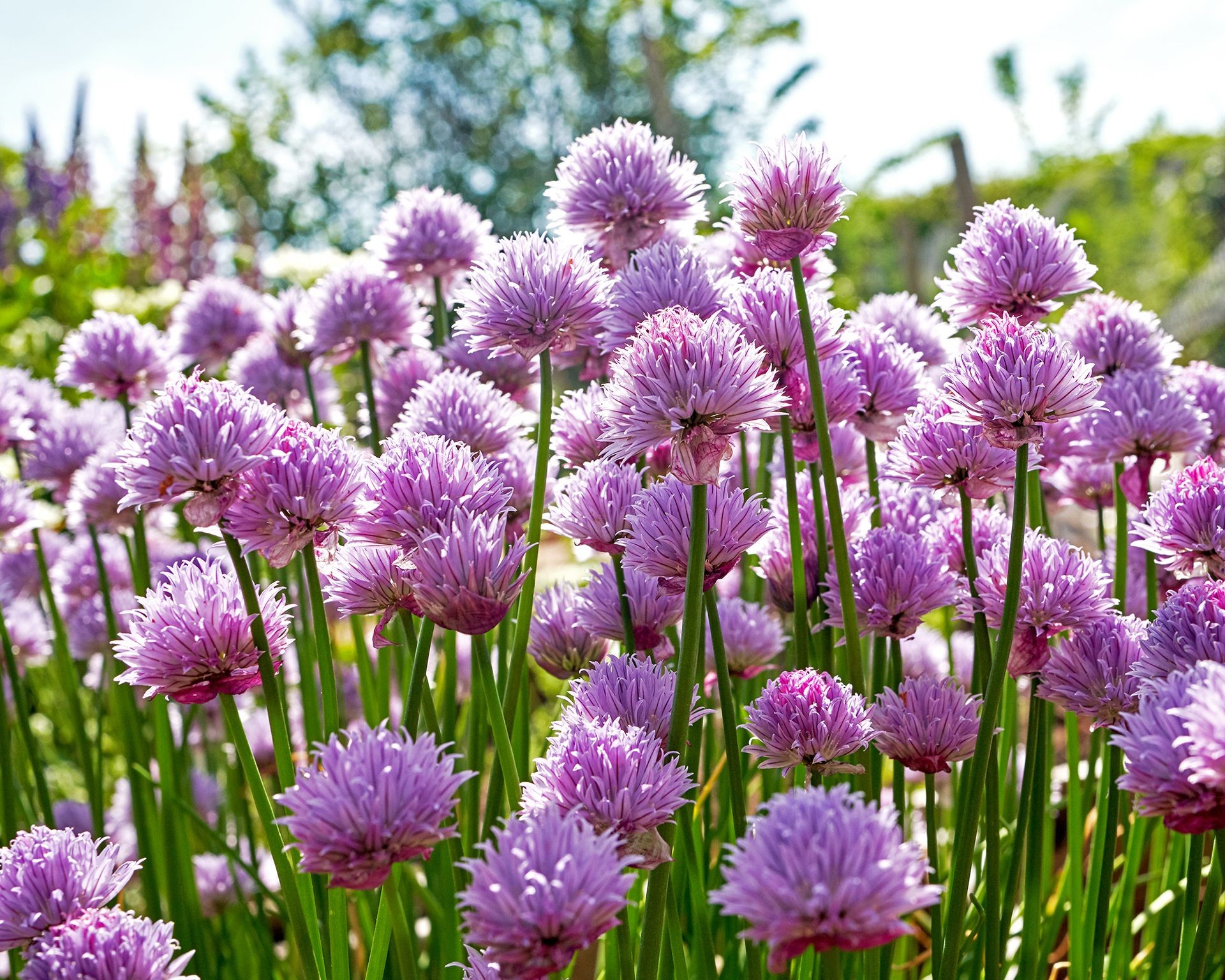 Close up of vibrant purple chive flowers blooming in a garden bed among other plants
Close up of vibrant purple chive flowers blooming in a garden bed among other plants
Extend The Growing Season With A Cold Frame
For gardeners eager to get a head start in spring or extend their harvest into cooler months, a cold frame is an invaluable tool. Functioning much like a miniature greenhouse, a cold frame provides a warmer microclimate for plants but is considerably more affordable and requires much less space.
A cold frame is essentially a bottomless box with a transparent lid (often made of glass or plastic) that can be opened and closed. The clear lid allows sunlight to enter, trapping heat inside and protecting plants from cold temperatures, wind, and frost. This creates a sheltered environment where seedlings can be started earlier in spring than they could outdoors.
Cold frames are perfect for “hardening off” seedlings that were started indoors. This process gradually acclimatizes young plants to outdoor conditions before they are permanently transplanted into the garden beds, reducing transplant shock. As the season progresses into fall and winter, a cold frame can protect cold-hardy crops like lettuce, spinach, kale, and root vegetables, allowing for continued harvesting well after the first frosts. It’s a simple yet effective way to maximize the use of your garden space and extend your growing ambitions across more of the year.
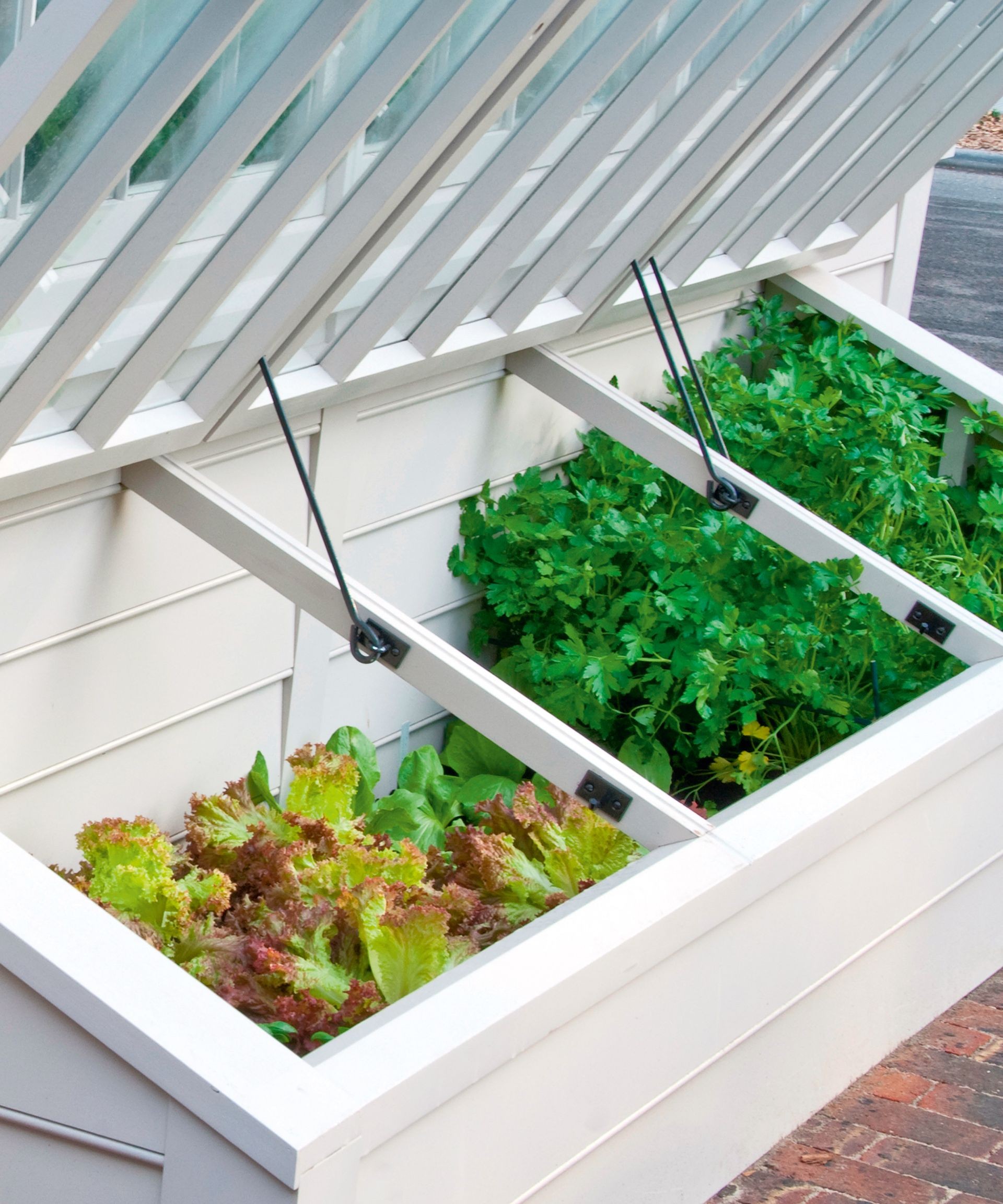 A wooden cold frame structure with a clear lid sits in a garden, protecting young salad greens and herbs planted inside
A wooden cold frame structure with a clear lid sits in a garden, protecting young salad greens and herbs planted inside
Avoid A Glut By Succession Planting
One common challenge in vegetable gardening is having all your produce ripen at once, leading to a temporary abundance followed by scarcity. Succession planting is a strategic technique designed to overcome this, ensuring a continuous, steady supply of fresh vegetables throughout the entire growing season. This method maximizes crop yields from your available space by spreading out the harvest window.
Succession planting can be achieved in several ways. The simplest is planting the same vegetable in small batches every few weeks instead of sowing the entire packet of seeds at once. For example, sowing a short row of lettuce or a couple of bush bean plants every two weeks ensures you have young plants maturing continuously. Another method involves planting different varieties of the same crop that have varying maturity dates (early, mid, and late-season). You can also rotate different crops through the same space as soon as one crop is harvested, immediately planting something else that is suitable for the current conditions.
The key benefits include a more manageable and consistent harvest, more efficient use of garden real estate (as beds are rarely left empty), and improved soil health over time, particularly when incorporating crop rotation within your succession plan.
Successful succession planting requires thoughtful planning. Consider the growth cycle of each plant, how long it takes from seeding to harvest, and when it’s appropriate to plant successive crops. For example, planting cool-season crops like radishes and spinach early in spring, followed by warm-season crops like tomatoes and peppers after the last frost, and then planting fall crops like kale and broccoli as temperatures cool, allows you to cycle through your beds effectively.
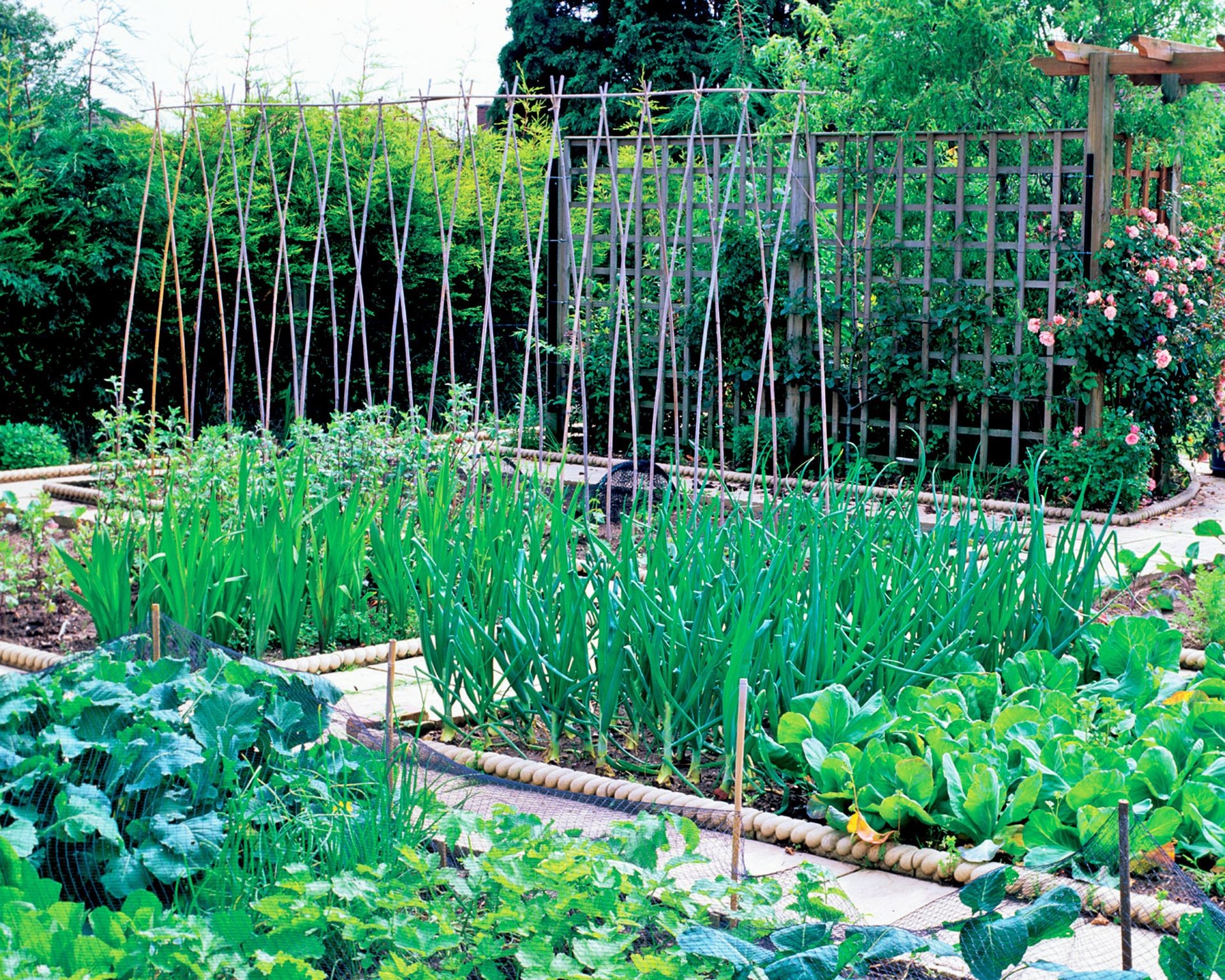 A lush, bountiful vegetable garden filled with a variety of maturing produce, illustrating the potential of successful planting and care
A lush, bountiful vegetable garden filled with a variety of maturing produce, illustrating the potential of successful planting and care
Grow A Vertical Vegetable Garden
Vertical vegetable gardening is an innovative solution for cultivating food when ground space is limited, and it also adds a dynamic visual element to larger gardens. By growing plants upward instead of outward, you can transform bare walls, fences, or small patio areas into productive and beautiful green spaces.
This method utilizes structures such as wall-mounted planters, multi-tiered shelves, trellises, or stacked containers to support plants as they grow vertically. It’s particularly effective for climbing plants but can also be adapted for leafy greens, herbs, and smaller fruiting vegetables.
Vertical gardening offers several practical advantages. Elevating plants improves air circulation around the foliage, which helps reduce the incidence of fungal diseases. Pest management can also become simpler as plants are more accessible and visible. Arranging vertical planters allows you to optimize sun exposure for each plant, ensuring they receive adequate light throughout the day.
Additionally, vertical setups reduce the need for bending and kneeling, making gardening more comfortable and accessible, especially for individuals with physical limitations. Common vegetables that thrive in vertical gardens include tomatoes, cucumbers, beans, peas, small squash varieties, strawberries, lettuce, spinach, and herbs. Choosing structures and plants that are compatible with the available vertical space is essential for a thriving vertical garden.
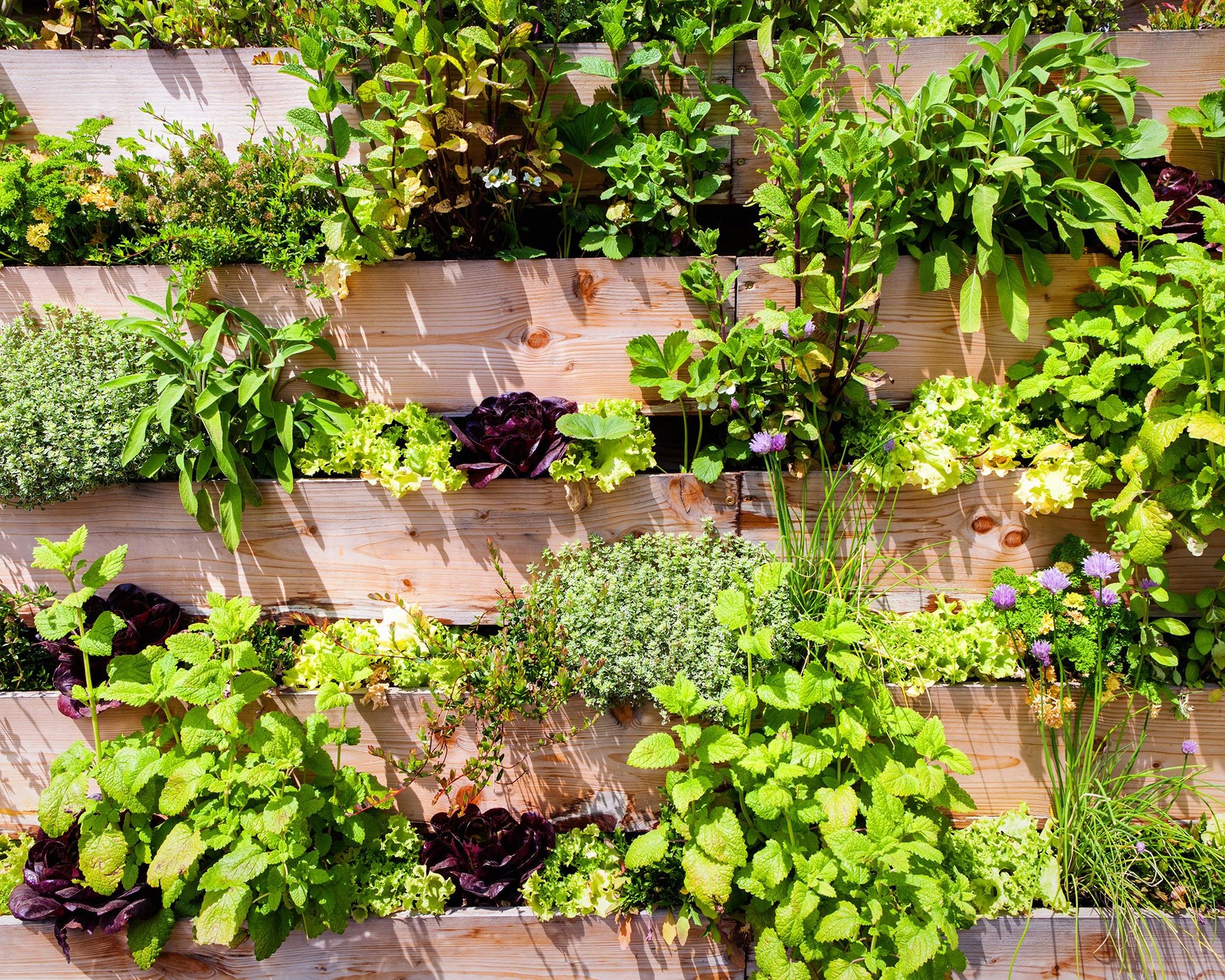 A vertical garden structure made of stacked containers or compartments is filled with various salad greens and herbs growing upwards
A vertical garden structure made of stacked containers or compartments is filled with various salad greens and herbs growing upwards
Improve Pathways And Hardscaping
Enhancing the functional and aesthetic elements around your vegetable garden, such as pathways and hardscaping, can significantly improve the overall gardening experience. Well-designed pathways provide essential access to your garden beds for planting, weeding, watering, and harvesting, preventing soil compaction from foot traffic.
Using materials like gravel, brick, stepping stones, or mulch for pathways creates defined routes that guide movement through the garden. This organization adds visual structure and makes the space more inviting and easier to navigate. Applying organic mulch, such as wood chips or straw, along pathways and garden borders not only enhances the garden’s appearance but also helps retain soil moisture in the beds and suppresses weed growth in surrounding areas.
Incorporating hardscaping features and decorative elements like arbors, decorative trellises (even if not used for climbing plants), or garden art can add focal points and personality to your vegetable garden. These additions transform the functional space into a more enjoyable and visually appealing retreat. Planning pathways and hardscaping alongside your bed layout ensures a cohesive and practical garden design.
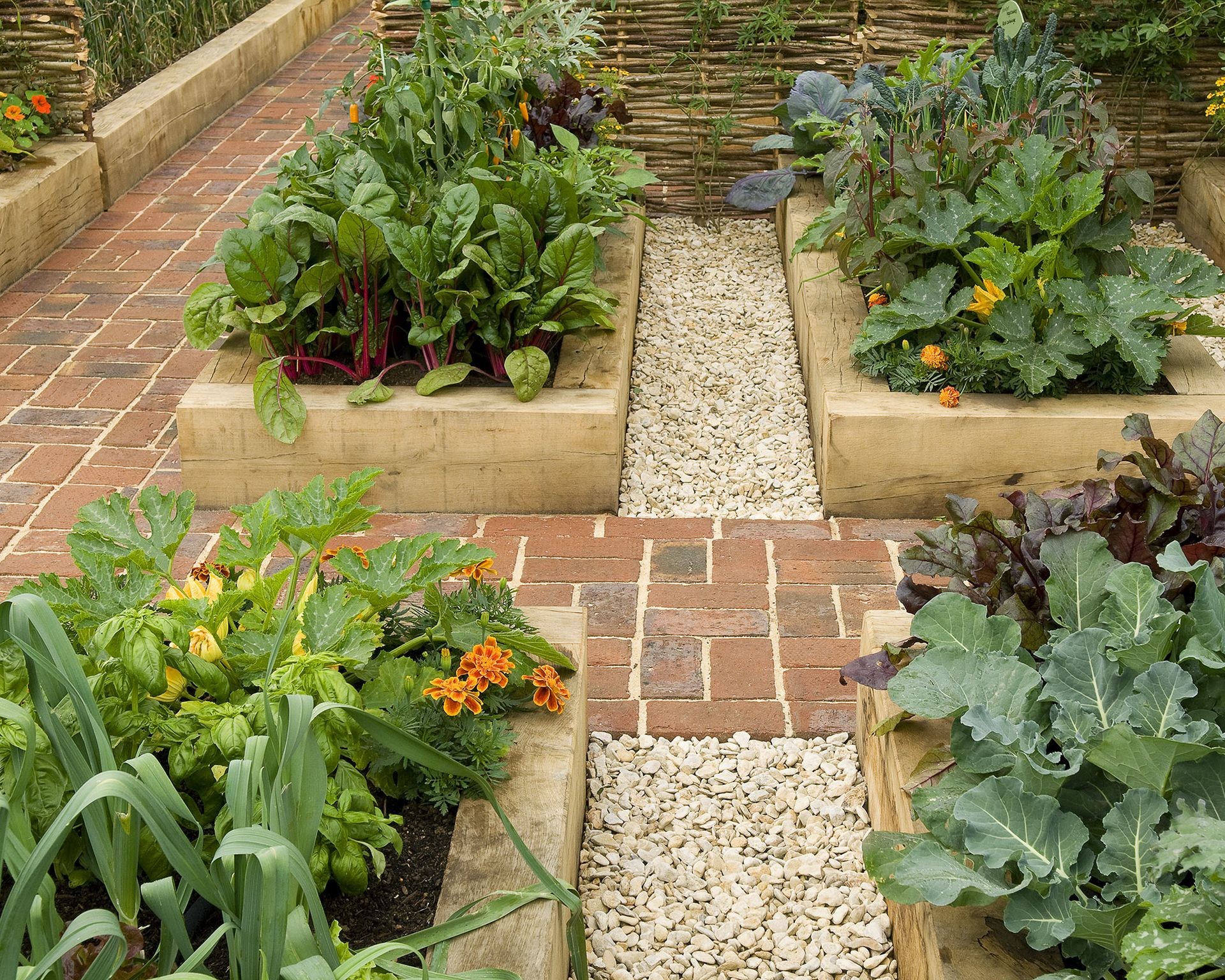 Attractive pathways made of brick and gravel wind through a vegetable garden area featuring raised beds, showing good design and access
Attractive pathways made of brick and gravel wind through a vegetable garden area featuring raised beds, showing good design and access
Plant To A Theme
Designing your vegetable garden around a specific theme can add a layer of personal expression and create a cohesive, intentional space. A themed garden reflects your interests, culinary preferences, or even aesthetic desires, making the gardening process more engaging. Themes can be based on color palettes, cultural cuisines, specific plant types, or functions like attracting wildlife.
Consider creating a pollinator-friendly vegetable garden explicitly designed to support bees, butterflies, and other beneficial insects crucial for plant pollination. Integrating flowering plants like marigolds, sunflowers, lavender, or borage alongside your vegetables helps attract these beneficial visitors, which in turn can improve the yield of your fruiting crops while supporting local biodiversity. Adding clear labels or decorative signs for each section or plant can enhance the theme and add a charming detail.
For a visually stunning approach, try a colorful vegetable garden focusing on crops with vibrant hues. A “purple patch” could feature purple carrots, eggplants, purple beans, and alongside lavender or purple basil for a harmonious and striking display. A “rainbow garden” might include varieties of tomatoes, peppers, corn, and leafy greens in a spectrum of colors.
Cultural themes are also popular and inspiring. An “Italian kitchen garden” could center around tomatoes, basil, zucchini, and peppers. A “Mexican garden” might feature peppers, cilantro, tomatillos, and perhaps some indigenous beans or corn varieties. Theming makes planning fun and connects your garden directly to your table and interests.
Make A Feature Of Fruit Trees
Incorporating espaliered fruit trees into your vegetable garden design adds both architectural beauty and productive potential, especially valuable in smaller spaces. Espalier is a horticultural technique where fruit trees, such as apple, pear, plum, or fig, are pruned and trained to grow flat against a wall, fence, or wire structure, creating a two-dimensional pattern.
This method is an excellent space-saving solution, allowing you to grow fruit trees without them casting large shadows that could impact sun-loving vegetables. Espaliered trees add vertical interest and structure to the garden landscape, acting as living walls or elegant backdrops.
Training trees in this manner improves air circulation and sunlight penetration through the branches, promoting healthier growth and often leading to increased fruit production compared to standard forms in tight spaces. Harvesting is also easier, and pest and disease management is simplified because the tree’s structure is open and accessible.
While espalier requires ongoing commitment to pruning and training to maintain the desired shape, the visual appeal and the bonus of homegrown fruit make it a worthwhile technique for integrating into a vegetable garden plan.
Conclusion
Cultivating your own vegetable garden, regardless of size, is a profoundly rewarding activity that enhances health, connects you with nature, and provides unparalleled access to fresh, flavorful food. As we’ve explored, numerous creative ideas and techniques can transform any space into a productive and beautiful growing area, from utilizing vertical dimensions and containers to strategic planting methods like succession planting and companion pairing.
Implementing ideas such as raised beds for ease and soil control, square foot gardening for maximum yield, or trellising for vining crops can make gardening more manageable and successful. Extending your season with simple structures like cold frames or adding personal touches with themed planting and ornamental herbs further enriches the experience. Even integrating elements like pathways and espaliered fruit trees can elevate your garden’s functionality and aesthetic appeal.
At Biogarden.Asia, we understand the passion that drives gardeners and are dedicated to providing the knowledge and resources you need to succeed. Whether you’re just starting or looking to enhance your existing garden, exploring these ideas is the first step towards a more abundant and enjoyable harvest. We encourage you to consider how these concepts can be applied to your specific space and goals. Start planning your dream garden today and experience the simple joy of growing your own food with support from Biogarden.Asia.
References
- University Extension Publications (e.g., from reputable state universities) on vegetable gardening, container gardening, raised beds, or specific crops.
- Classic Gardening Manuals (e.g., Rodale’s Encyclopedia of Organic Gardening).
- Horticultural Society Resources (e.g., American Horticultural Society).
- Academic Journals or Studies on plant science and sustainable agriculture practices.
- Experienced Gardeners and Local Horticultural Experts.



